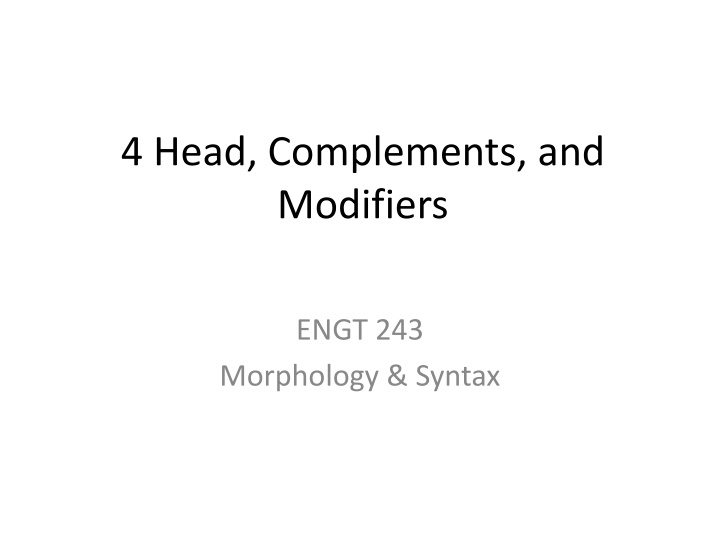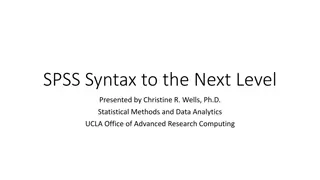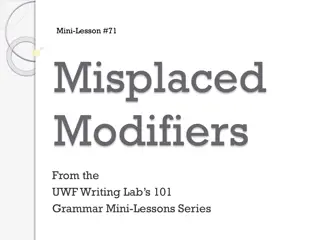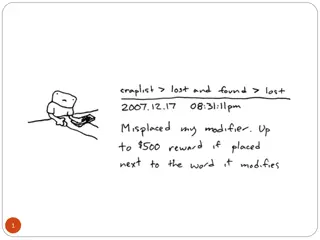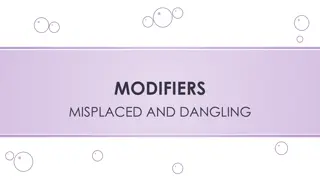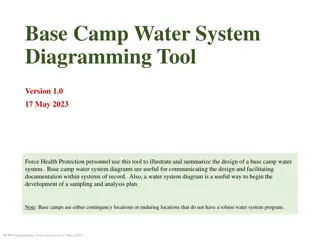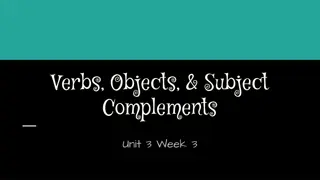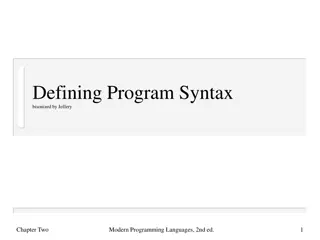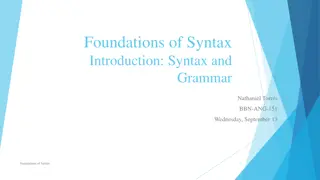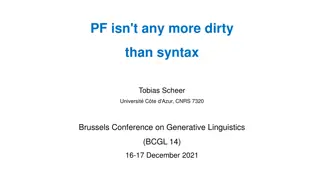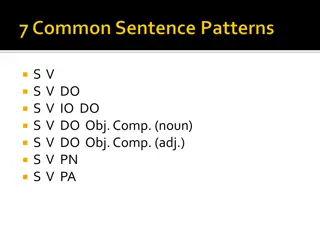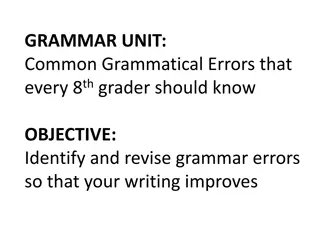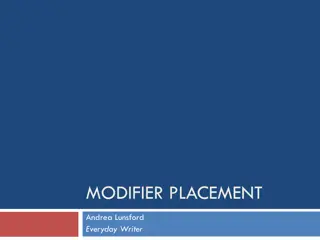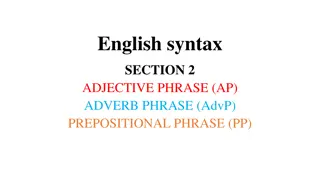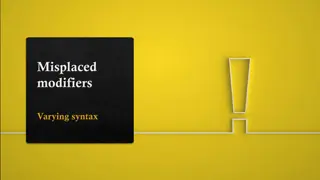Head, Complements, and Modifiers in Syntax Analysis
In the study of English sentences, the roles of syntactic categories and grammatical functions are crucial. Explore internal and external syntax, along with examples illustrating the construction of phrases. Discover how the properties of verbs influence the acceptability of phrases within different syntactic contexts.
Download Presentation

Please find below an Image/Link to download the presentation.
The content on the website is provided AS IS for your information and personal use only. It may not be sold, licensed, or shared on other websites without obtaining consent from the author.If you encounter any issues during the download, it is possible that the publisher has removed the file from their server.
You are allowed to download the files provided on this website for personal or commercial use, subject to the condition that they are used lawfully. All files are the property of their respective owners.
The content on the website is provided AS IS for your information and personal use only. It may not be sold, licensed, or shared on other websites without obtaining consent from the author.
E N D
Presentation Transcript
4 Head, Complements, and Modifiers ENGT 243 Morphology & Syntax
4.1 Projections from Lexical Heads to Phrases As we have seen in the previous chapters, both 1. syntactic categories (NP, AP, VP, PP, etc.) 2. grammatical functions (subject, complement, and modifier) play important roles in the analysis of English sentences. We have also observed that the grammatical function and form of each constituent depend on where it occurs or what it combines with.
4.1.1 Internal vs. External Syntax Internal syntax deals with how a given phrase itself is constructed in a well-formed manner External syntax is concerned with how a phrase can be used in a larger construction. Observe the following examples: (1) a. *John [put his gold]. b. *John [put under the bathtub]. c. *John [put his gold safe]. d. *John [put his gold to be under the bathtub]. e. John [put his gold under the bathtub].
4.1.1 Internal vs. External Syntax Internal syntax (1) e. John [put his gold under the bathtub]. Why is only (1e) acceptable? because only it satisfies the condition that the verb put selects an NP and a PP as its complements, and it combines with them in the VP. In the other examples, this condition is NOT fulfilled. This combinatory requirement starts from the internal (or lexical) properties of the verb put, and is not related to any external properties of the VP.
4.1.1 Internal vs. External Syntax External syntax is concerned with the external environment in which a phrase occurs. Some of the unacceptable examples in (1) can be legitimate expressions if they occur in the proper (syntactic) context. (2) a. This is the box in which John [put his gold]. (cf. (1a)) b. This is the gold that John [put under the bathtub]. (cf. (1b))
4.1.1 Internal vs. External Syntax External syntax Meanwhile, the well-formed VP in (1e) can be unacceptable, depending on external contexts. For example, consider frame induced by the governing verb kept in (3): (3) a. *The king kept [put his gold under the bathtub]. b. The king kept [putting his gold under the bathtub]. The VP put his gold under the bathtub is a well-formed phrase, but cannot occur in (3a) since this is not the environment where such a finite VP occurs. That is, the verb kept requires the presence of a gerundive VP like putting his gold under the bathtub, and therefore imposes an external constraint on VPs.
4.1.2 Notion of Head, Complements, and Modifiers One important property we observe in English phrase- internal syntax is that in building up any phrase, there is one obligatory essential element in each phrase. This essential element is the head of the phrase.
4.1.2 Notion of Head, Complements, and Modifiers The head of each phrase determines its projection into a larger phrasal constituent. The head of an NP is thus N The head of a VP is V The head of an AP is A
4.1.2 Notion of Head, Complements, and Modifiers The notion of headedness plays an important role in the grammar. For example, the verb put, functioning as the head of a VP, dictates what it must combine with two complements, NP and PP. John [put his gold under the bathtub].
4.1.2 Notion of Head, Complements, and Modifiers (5) a. The defendant denied the accusation. b. *The defendant denied. (6) a. The teacher handed the student a book. b. *The teacher handed the student. denied here requires an NP object. handed requires two NP complements.
4.1.2 Notion of Head, Complements, and Modifiers The properties of the head verb itself determine what kind of elements it will combine with. The elements which a head verb should combine with are called complements. According to some verb or other: the complements include - direct object - indirect object - predicative complement - oblique complement
4.1.2 Notion of Head, Complements, and Modifiers The properties of the head become properties of the whole phrase. Why are the examples in (7b) and (8b) ungrammatical? (7) a. They [want to leave the meeting]. b. *They [eager to leave the meeting]. (8) a. The senators [know that the president is telling a lie]. b. *The senators [certain that the president is telling a lie]. The examples in (7b) and (8b) are unacceptable because of the absence of the required head.
4.1.2 Notion of Head, Complements, and Modifiers The unacceptable examples lack a finite (tensed) VP as the bracketed part, but we know that English sentences require a finite VP as their immediate constituent, as informally represented as in (9): (9) English Declarative Sentence Rule: Each declarative sentence must contain a finite VP.
4.1.2 Notion of Head, Complements, and Modifiers Each finite VP is headed by a finite verb. If we amend the ungrammatical examples above to include a verb but not a finite one, they are still ungrammatical: (10) a. *They [(to) be eager to leave the meeting]. b. *The senators [(to) be certain that the president is telling a lie]. The VP is considered to be the (immediate) head of the sentence, with the verb itself as the head of the VP. In this way, we can talk about a finite or non-finite sentence, one which is ultimately headed by a finite or nonfinite verb, respectively.
4.1.2 Notion of Head, Complements, and Modifiers In addition to the complements of a head, a phrase may also contain modifiers: (11) a. Tom [VP [VP offered advice to his students] in his office]. b. Tom [VP [VP offered advice to his students] with love]. The PPs in his office or with love here provide further information about the action described by the verb, but are not required as such by the verb.
4.1.2 Notion of Head, Complements, and Modifiers (11) a. Tom [VP [VP offered advice to his students] in his office]. b. Tom [VP [VP offered advice to his students] with love]. - These phrases are optional and function as modifiers. - They function to augment the minimal phrase projected from the head verb offered.
4.1.2 Notion of Head, Complements, and Modifiers (11) a. Tom [VP [VP offered advice to his students] in his office]. b. Tom [VP [VP offered advice to his students] with love]. The VP which includes this kind of modifier forms a maximal phrase. The inner VP here forms a minimal VP which includes all the minimally required complements. The outer VP is the maximal VP which includes optional modifiers.
4.1.2 Notion of Head, Complements, and Modifiers What we have seen can be summarized as follows: a. Head: A lexical or phrasal element that is essential in forming a phrase. b. Complement: A phrasal element that a head must combine with or a head select. These include direct object, indirect object, predicative complement, and oblique complement.
4.1.2 Notion of Head, Complements, and Modifiers c. Modifier: A phrasal element not selected by the verb functions as a modifier to the head phrase. d. Minimal Phrase: A minimal phrase is the phrase including this head and all of its complements. e. Maximal Phrase: A XP (VP/NP/AP) that includes complements as well as modifiers.
